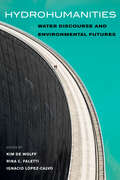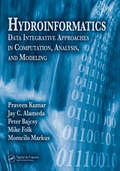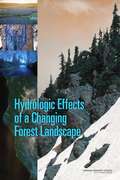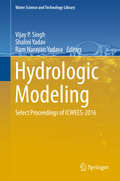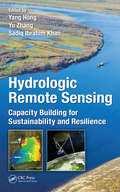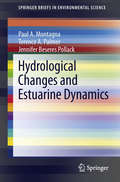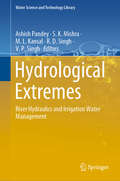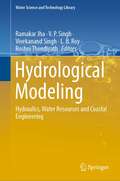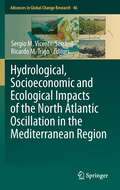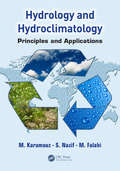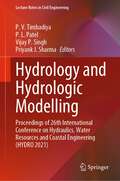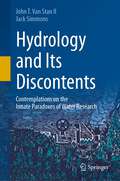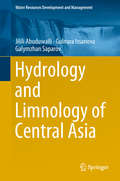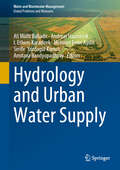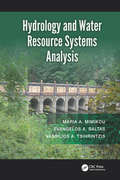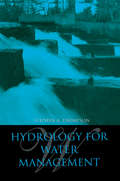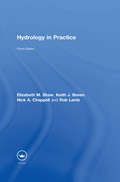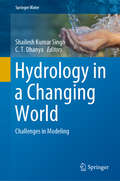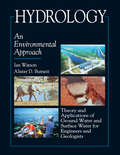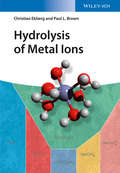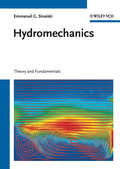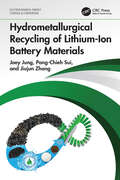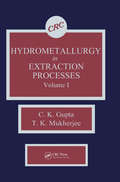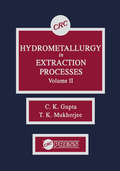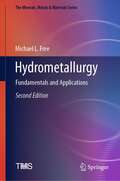- Table View
- List View
Hydrohumanities: Water Discourse and Environmental Futures
by Kim De Wolff, Rina C. Faletti and Ignacio López-CalvoA free open access ebook is available upon publication. Learn more at www.luminosoa.org. Discourse about water and power in the modern era have largely focused on human power over water: who gets to own and control a limited resource that has incredible economic potential. As a result, discussion of water, even in the humanities, has traditionally focused on fresh water for human use. Today, climate extremes from drought to flooding are forcing humanities scholars to reimagine water discourse. This volume exemplifies how interdisciplinary cultural approaches can transform water conversations. The manuscript is organized into three emergent themes in water studies: agency of water, fluid identities, and cultural currencies. The first section deals with the properties of water and the ways in which water challenges human plans for control. The second section explores how water (or lack of it) shapes human collective and individual identities. The third engages notions of value and circulation to think about how water has been managed and employed for local, national, and international gains. Contributions come from preeminent as well as emerging voices across humanities fields including history, art history, philosophy, and science and technology studies. Part of a bigger goal for shaping the environmental humanities, the book broadens the concept of water to include not just water in oceans and rivers but also in pipes, ice floes, marshes, bottles, dams, and more. Each piece shows how humanities scholarship has world-changing potential to achieve more just water futures.
Hydroinformatics: Data Integrative Approaches in Computation, Analysis, and Modeling
by Praveen Kumar Mike Folk Momcilo Markus Jay C. AlamedaModern hydrology is more interdisciplinary than ever. Staggering amounts and varieties of information pour in from GIS and remote sensing systems every day, and this information must be collected, interpreted, and shared efficiently. Hydroinformatics: Data Integrative Approaches in Computation, Analysis, and Modeling introduces the tools, approache
Hydrologic Effects of a Changing Forest Landscape
by National Research Council of the National AcademiesOf all the outputs of forests, water may be the most important. Streamflow from forests provides two-thirds of the nation's clean water supply. Removing forest cover accelerates the rate that precipitation becomes streamflow; therefore, in some areas, cutting trees causes a temporary increase in the volume of water flowing downstream. This effect has spurred political pressure to cut trees to increase water supply, especially in western states where population is rising. However, cutting trees for water gains is not sustainable: increases in flow rate and volume are typically short-lived, and the practice can ultimately degrade water quality and increase vulnerability to flooding. Forest hydrology, the study of how water flows through forests, can help illuminate the connections between forests and water, but it must advance if it is to deal with today's complexities, including climate change, wildfires, and changing patterns of development and ownership. This book identifies actions that scientists, forest and water managers, and citizens can take to help sustain water resources from forests.
Hydrologic Modeling
by Vijay P Singh Shalini Yadav Ram Narayan YadavaThis book contains seven parts. The first part deals with some aspects of rainfall analysis, including rainfall probability distribution, local rainfall interception, and analysis for reservoir release. Part 2 is on evapotranspiration and discusses development of neural network models, errors, and sensitivity. Part 3 focuses on various aspects of urban runoff, including hydrologic impacts, storm water management, and drainage systems. Part 4 deals with soil erosion and sediment, covering mineralogical composition, geostatistical analysis, land use impacts, and land use mapping. Part 5 treats remote sensing and geographic information system (GIS) applications to different hydrologic problems. Watershed runoff and floods are discussed in Part 6, encompassing hydraulic, experimental, and theoretical aspects. Water modeling constitutes the concluding Part 7. Soil and Water Assessment Tool (SWAT), Xinanjiang, and Soil Conservation Service-Curve Number (SCS-CN) models are discussed. The book is of interest to researchers and practitioners in the field of water resources, hydrology, environmental resources, agricultural engineering, watershed management, earth sciences, as well as those engaged in natural resources planning and management. Graduate students and those wishing to conduct further research in water and environment and their development and management find the book to be of value.
Hydrologic Remote Sensing: Capacity Building for Sustainability and Resilience
by Yu Zhang Yang Hong Sadiq Ibrahim KhanEnvironmental remote sensing plays a critical role in observing key hydrological components such as precipitation, soil moisture, evapotranspiration and total water storage on a global scale. As water security is one of the most critical issues in the world, satellite remote sensing techniques are of particular importance for emerging regions which have inadequate in-situ gauge observations. This book reviews multiple remote sensing observations, the application of remote sensing in hydrological modeling, data assimilation and hydrological capacity building in emerging regions.
Hydrological Changes and Estuarine Dynamics
by Paul Montagna Terence A. Palmer Jennifer Beseres PollackWater development projects have altered the environmental flow landscapes where dams and diversions have been built, and this could have effects on coastal resources, particularly in estuaries. Water is an important human resource and water needs grow as populations grow. However, freshwater inflow to the coast is fundamental to the functioning of estuaries. Can we have stable, secure, and sufficient water resources for people and still protect estuarine health? Estuaries are the most productive environments on Earth, and this is in part due to freshwater inflow, which dilutes marine water, and transports nutrients and sediments to the coast. Estuaries are characterized by salinity and nutrient gradients, which are important in regulating many biological processes. As water is diverted for human consumption, it is common for many environmental problems to appear. While many countries have water quality programs, few are dealing with water quantity alterations. The first step is to define marine resources to protect, and the water quality conditions those resources need to thrive. The second step is to determine the flow regimes needed to maintain the desired water quality conditions. Finally, many regions are using adaptive management programs to manage freshwater resources. These programs set goals to protect ecosystem resources, identify indicators, and monitor the indicators over time to ensure that the goals are appropriate and resources are protected. Case studies demonstrate that monitoring and research can determine the ecological and socio-economical impacts of altered freshwater inflows, and stakeholders and managers can make well-informed decisions to manage freshwater inflows to local coasts wisely.
Hydrological Extremes: River Hydraulics and Irrigation Water Management (Water Science and Technology Library #97)
by V. P. Singh Ashish Pandey S. K. Mishra M. L. Kansal R. D. SinghThis book presents quality technical papers representing the recent developments in the field of hydrological modeling, water management and water governance including practical applications. The content covers multifarious aspects of hydrology and water resources. It includes an application of the Hydrologic Modelling System (HEC-HMS) which has been successfully demonstrated for assessment of floods. The authors suggest an approach for the mitigation of cyclone disaster through a case study of the Phailin cyclone, whilst considering mitigating pluvial flooding, developing suitable management strategies. The book includes chapters discussing the detrended fluctuation analysis which is carried out for multifractal description of droughts. Drought characteristics are analyzed, and drought indices evolved for drought preparedness/management. The use of science in community planning under changing climate is also studied and discussed. The authors present and experimental study wherein hydraulic coefficients are calibrated by using vertical orifice. A cross flow hybrid hydrokinetic turbine is also evaluated for performance, and high head regulating radial gate designed and studied its sensitivity.This book will appeal to researchers, field practitioners, NGO and other Governmental as well as private water practitioners
Hydrological Modeling: Hydraulics, Water Resources and Coastal Engineering (Water Science and Technology Library #109)
by V. P. Singh Ramakar Jha Vivekanand Singh L. B. Roy Roshni ThendiyathThis book carefully considers hydrological models which are essential for predicting floods, droughts, soil moisture estimation, land use change detection, geomorphology and water structures. The book highlights recent advances in the area of hydrological modelling in the Ganga Basin and other internationally important river basins. The impact of climate change on water resources is a global concern. Water resources in many countries are already stressed, and climate change along with burgeoning population, rising standard of living and increasing demand are adding to the stress. Furthermore, river basins are becoming less resilient to climatic vagaries. Fundamental to addressing these issues is hydrological modelling which is covered in this book. Integrated water resources management is vital to ensure water and food security. Integral to the management is groundwater and solute transport, and this book encompasses tools that will be useful to mitigate the adverse consequences of natural disasters.
Hydrological, Socioeconomic and Ecological Impacts of the North Atlantic Oscillation in the Mediterranean Region
by Sergio M. Vicente-Serrano Ricardo M. TrigoThe Mediterranean basin represents one of the most important "hot spots" of climate change in the world, with recent trends towards a hotter and drier climate being related to changes in atmospheric circulation patterns. Such changes can have significant impacts in the climate of this region but also on the natural environment and several socioeconomic activities. Among these patterns, the North Atlantic Oscillation (NAO) is one of the main forcing factors in the region with impact on extreme events such as droughts, severe precipitations or heat and cold waves, the availability of water resources, the ecological dynamics, the quality and quantity of crops, the migration and welfare of animal populations, the fisheries dynamics, the triggering of landslides and the air pollution and human health, among others. The aim of Hydrological, Socioeconomic and Ecological Impacts of the North Atlantic Oscillation in the Mediterranean Region, is to serve as an updated reference text that covers the wide range of evidences on the NAO impacts in the Mediterranean regions and from a multidisciplinary perspective. This volume constitutes a unique document to present the state of the art of the numerous studies undertaken on the hydrological, socioeconomic and ecological impact of the NAO, collecting the expertise of researchers from several complementary earth science fields (geography, hydrology, remote-sensing, climatology, agriculture, energy), but that have been lacking a common ground.
Hydrology and Hydroclimatology: Principles and Applications
by M. Karamouz S. Nazif M. FalahiThis book presents a systematic approach to understanding and applying the principles of hydrology and hydroclimatology, examining the interactions among different components of the water cycle. It takes a fresh look at the fundamentals and challenges in hydrologic and hydroclimatic systems as well as climate change. The author describes the applic
Hydrology and Hydrologic Modelling: Proceedings of 26th International Conference on Hydraulics, Water Resources and Coastal Engineering (HYDRO 2021) (Lecture Notes in Civil Engineering #312)
by Vijay P. Singh P. V. Timbadiya Priyank J. Sharma P. L. PatelThis book comprises the proceedings of the 26th International Conference on Hydraulics, Water Resources and Coastal Engineering (HYDRO 2021) focusing on broad spectrum of emerging opportunities and challenges in the field of hydrology and hydrological modelling. It covers a range of topics, including, but not limited to, ground water modelling and management, integrated water resources and watershed management, surface water hydrology, drought assessment and mitigation, risk, reliability and design of hydrologic system, etc. Presenting recent advances in the form of illustrations, tables, and text, it offers readers insights for their own research. In addition, the book addresses fundamental concepts and studies in the field of hydrology and hydrological modelling, making it a valuable resource for both beginners and researchers wanting to further their understanding of hydraulics, water resources and coastal engineering.
Hydrology and Its Discontents: Contemplations on the Innate Paradoxes of Water Research
by Jack Simmons John T. Van Stan IIThis book examines the intricate web linking water science and society using diverse philosophical lenses. Highlighting the tensions within the threads of this web, we spotlight major conceptual tightropes that water researchers tread daily. To effectively navigate these delicate threads, a 'healthy' tension in the encompassing web is necessary. Drawing inspiration from Freud's examination of tensions in "Society and Its Discontents," we illuminate the tension-filled paradoxes inherent to water science, emphasizing the challenges in keeping these paradoxical threads taut enough to ensure a navigable and sustainable bond with society. Central to our narrative is the escalating societal urge to quantify and 'manage' water—something interwoven throughout every environmental layer, including the fabric of our being. An excessive focus on management may alienate users from their water realities, jeopardizing the vital threads that sustainability tether water science and society. Consequently, this book explores compelling and inescapable tensions that resist tidy universal resolution, such as: the language of water science, including its mathematical reductions (i.e., models); the effect of water's commodification on its science; hydrology’s intersection with colonialism; and other concerns that reveal distortions in our hydrology. We aim to aid water professionals in recognizing and fine-tuning the paradoxes intrinsic to their work. To underscore the interwoven complexity of contemporary hydrology, "Hydrology and Its Discontents" guides readers into the tempestuous depths of water research, all the while urging a recalibration of perspectives and motivations.
Hydrology and Limnology of Central Asia (Water Resources Development and Management)
by Gulnura Issanova Jilili Abuduwaili Galymzhan SaparovThis book highlights the development of lake systems and water reservoirs as well as the impact of climate change on water resources in Central Asian countries. It provides information on the genesis of lake basins, physical and chemical properties of water in lakes, and the hydrological regimes (water balance and fluctuation levels) of lakes of Central Asia and Xinjiang. The book is useful for scientists and researchers whose work focuses on lakes and the use of natural resources, irrigation, hydropower and water supply, as well as for students and planners.
Hydrology and Urban Water Supply (Water and Wastewater Management)
by Amitava Bandyopadhyay Andreas Haarstrick Ali Müfit Bahadir I. Ethem Karadirek Mehmet Emin Aydin Serife Yurdagül KumcuThis book explores the intricate relationship between hydrology and urban water provision. Authored by experts in the field, this book offers a comprehensive exploration of the challenges and solutions associated with urban water supply management in the context of hydrology. It covers topics such as water sources, treatment technologies, distribution systems, and sustainable water management practices. With its meticulous analysis and practical insights, this book equips professionals, researchers, and policymakers with the knowledge necessary to address the growing demands of urban water supply in an era of climate change and urbanization.
Hydrology and Water Resource Systems Analysis
by Maria A. Mimikou Evangelos A. Baltas Vassilios A. TsihrintzisHydrology and water resources analysis can be looked at together, but this is the only book which presents the relevant material and which bridges the gap between scientific processes and applications in one text. New methods and programs for solving hydrological problems are outlined in a concise and readily accessible form. Hydrology and Water Resource Systems Analysis includes a number of illustrations and tables, with fully solved example problems integrated within the text. It describes a systematic treatment of various surface water estimation techniques; and provides detailed treatment of theory and applications of groundwater flow for both steady-state and unsteady-state conditions; time series analysis and hydrological simulation; floodplain management; reservoir and stream flow routing; sedimentation and erosion hydraulics; urban hydrology; the hydrological design of basic hydraulic structures; storage spillways and energy dissipation for flood control, optimization techniques for water management projects; and methods for uncertainty analysis. It is written for advanced undergraduate and graduate students and for practitioners. Hydrologists and water-related professionals will be helped with an unfamiliar term or a new subject area, or be given a formula, the procedure for solving a problem, or guidance on the computer packages which are available, or shown how to obtain values from a table of data. For them it is a compendium of hydrological practice rather than science, but sufficient scientific background is provided to enable them to understand the hydrological processes in a given problem, and to appreciate the limitations of the methods presented for solving it.
Hydrology for Water Management
by Stephen A. ThompsonContaining over one hundred and sixty line drawings, maps and one hundred tables, this book explains the fundamental hydrologic principles and favoured methods of analysis. Aimed at students interested in natural resources and environmental science, spreadsheet exercises and worked examples help to develop basic problem solving skills.
Hydrology in Practice
by Elizabeth M. Shaw Keith J. Beven Nick A. Chappell Rob LambHydrology in Practice is an excellent and very successful introductory text for engineering hydrology students who go on to be practitioners in consultancies, the Environment Agency, and elsewhere. This fourth edition of Hydrology in Practice, while retaining all that is excellent about its predecessor, by Elizabeth M. Shaw, replaces the material on the Flood Studies Report with an equivalent section on the methods of the Flood Estimation Handbook and its revisions. Other completely revised sections on instrumentation and modelling reflect the many changes that have occurred over recent years. The updated text has taken advantage of the extensive practical experience of the staff of JBA Consulting who use the methods described on a day-to-day basis. Topical case studies further enhance the text and the way in which students at undergraduate and MSc level can relate to it. The fourth edition will also have a wider appeal outside the UK by including new material on hydrological processes, which also relate to courses in geography and environmental science departments. In this respect the book draws on the expertise of Keith J. Beven and Nick A. Chappell, who have extensive experience of field hydrological studies in a variety of different environments, and have taught undergraduate hydrology courses for many years. Second- and final-year undergraduate (and MSc) students of hydrology in engineering, environmental science, and geography departments across the globe, as well as professionals in environmental protection agencies and consultancies, will find this book invaluable. It is likely to be the course text for every undergraduate/MSc hydrology course in the UK and in many cases overseas too.
Hydrology in a Changing World: Challenges in Modeling (Springer Water)
by Shailesh Kumar Singh C. T. DhanyaThis book offers a comprehensive overview of the challenges in hydrological modeling. Hydrology, on both a local and global scale, has undergone dramatic changes, largely due to variations in climate, population growth and the associated land-use and land-cover changes. Written by experts in the field, the book provides decision-makers with a better understanding of the science, impacts, and consequences of these climate and land-use changes on hydrology. Further, offering insights into how the changing behavior of hydrological processes, related uncertainties and their evolution affect the modeling process, it is of interest for all researchers and practitioners using hydrological modeling.
Hydrology: An Environmental Approach
by Ian WatsonHydrology covers the fundamentals of hydrology and hydrogeology, taking an environmental slant dictated by the emphasis in recent times for the remediation of contaminated aquifers and surface-water bodies as well as a demand for new designs that impose the least negative impact on the natural environment. Major topics covered include hydrological principles, groundwater flow, groundwater contamination and clean-up, groundwater applications to civil engineering, well hydraulics, and surface water. Additional topics addressed include flood analysis, flood control, and both ground-water and surface-water applications to civil engineering design.
Hydrolysis of Metal Ions
by Christian Ekberg Paul L. BrownFilling the need for a comprehensive treatment that covers the theory, methods and the different types of metal ion complexes with water (hydrolysis), this handbook and ready reference is authored by a nuclear chemist from academia and an industrial geochemist. The book includes both cation and anion complexes, and approaches the topic of metal ion hydrolysis by first covering the background, before proceeding with an overview of the dissociation of water and then all different metal-water hydrolysis complexes and compounds. A must-have for scientists in academia and industry working on this interdisciplinary topic.
Hydromechanics: Theory and Fundamentals
by Emmanuil G. SinaiskiWritten by an experienced author with a strong background in applications of this field, this monograph provides a comprehensive and detailed account of the theory behind hydromechanics. He includes numerous appendices with mathematical tools, backed by extensive illustrations. The result is a must-have for all those needing to apply the methods in their research, be it in industry or academia.
Hydrometallurgical Recycling of Lithium-Ion Battery Materials (Electrochemical Energy Storage and Conversion)
by Jiujun Zhang Joey Jung Pang-Chieh SuiThe expanding market share of lithium-ion batteries (LIBs), driven by the secondary battery and electric vehicle markets, has consequently led to the accumulation of spent LIBs. This presents a unique business opportunity for recovering and recycling valuable metals from the spent lithium-ion cathode materials. Hydrometallurgical Recycling of Lithium-Ion Battery Materials provides a comprehensive review of the available hydrometallurgical technologies for recycling spent lithium-ion cathode active materials. The aim of this book is to raise awareness of LIB recycling, provide comprehensive knowledge of hydrometallurgical recycling of lithium cathode active materials, and promote an environmentally friendlier hydrometallurgical recycling process. Key Features • Summarizes current recycling processes, challenges, and perspectives • Offers a comprehensive review of current commercialized LIB recycling companies • Showcases an innovative closed-loop hydrometallurgical recycling process to recycle lithium cathode materials • Provides detailed modeling and economic analyses of several hydrometallurgical recycling processes • Features practical cases and data developed by the authors Offering the most up-to-date information on LIB material recycling, this book is aimed at researchers and professionals in materials, chemical, electrical, and mechanical engineering, as well as chemists working on battery technologies.
Hydrometallurgy in Extraction Processes, Volume I
by T.K. MukherjeeThis two-volume set provides a full account of hydrometallurgy. Filled with illustrations and tables, this work covers the flow of source material from the mined or concentrate state to the finished product. It also highlights ion exchange, carbon adsorption and solvent extraction processes for solution purification and concentration. The extensive
Hydrometallurgy in Extraction Processes, Volume II
by C. K. Gupta T. K. MukherjeeThis two-volume set provides a full account of hydrometallurgy. Filled with illustrations and tables, this work covers the flow of source material from the mined or concentrate state to the finished product. It also highlights ion exchange, carbon adsorption and solvent extraction processes for solution purification and concentration. The extensive reference list-over 850-makes this set a valuable resource for extraction and process metallurgists, researchers, and practitioners.
Hydrometallurgy: Fundamentals and Applications (The Minerals, Metals & Materials Series)
by Michael L. FreeThis revised, new edition retains its class-tested coverage of how metals behave in water while updating and expanding information about metals processing methods. The book further retains its emphasis on predicting and engineering the way metals are extracted from ore sources, separated from unwanted entities, recovered as metals, and purified using water based processing. The transformation of minerals to metals requires hydrometallurgical processing for nearly all of the nonferrous metals we use. This book elucidates the associated fundamentals and processing applications as well as related tools to assess processes and performance. The new edition further includes additional photographs, updated drawings, supplementary data, updated descriptive information, and new detail on rare earth elements processing as well as recycling and byproduct recovery of metals.
